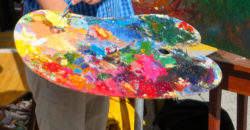Art has a story
 Jerome Bruner has written that we make meaning of our world through story. We are constantly storying ourselves (and others, and the world around us).
Jerome Bruner has written that we make meaning of our world through story. We are constantly storying ourselves (and others, and the world around us).
Making art is no different. As the art pieces for 37days started flowing in, so did the back-stories of how they were made, why they were significant for the artist, what they meant to them. I’ve asked each artist, if they are interested, to provide the story of their artwork because it so enhances my understanding of the art itself. I’m struck, too, by the serendipitous way in which some artists were assigned what seem to be the perfect essays for them… While I can’t post them all, unfortunately, perhaps you’d like hear a few of these stories, too, over the coming weeks.
Here’s an Artist’s Statement from Adele Wayman who created an artwork for "Polish your mudballs."
"Creating the artist card for ‘Polish Your Mudballs’ began with my immediate recognition and response to the quote at the top of the essay. It was written by Dogen Zenji who was born in Japan in the 12th century and was the founder of Soto Zen, the Buddhist practice I follow at Great Tree
I should really rewrite my paragraph to say that my process and materials were really the starting point and the spiritual and philosophical musings emerged from them. My current art practice is to make ephemeral constructions out of natural materials and/or flea market treasures of lace and old stuff as a way to create sacred settings for my paintings. The images are really wall-sized collages or wall altars ("wallters!" from my friend Anne). I began playing with all the small leaf paintings in my studio and finally this one of the central falling maple leaves was the right feeling, color and texture. The real red and yellow leaves on the black from the red maple outside my Forest Light studio kept moving around. For awhile there were also golden beech leaves. The dorodango are computer prints from Bruce Gardner’s beautiful examples on his website and they were everywhere in the image until they found a balance.
The practice of making mudballs, taking dirt and making it shine is like following each breath in meditation, making art, or polishing your life each day, one image and one breath at a time.
Meditation on Katagiri Roshi’s teaching on A Painting of A Rice Cake
A painted rice cake doesn’t satisfy hunger.
Wanting food, I continually search for answers.
Struggling to make sense of the dharma, I paint rice cakes.
Paper, colors, paint, brushes – what to do with them.
Paint to find enlightenment, the perfect image.
Unable to satisfy the hunger, not wanting to starve,
Amazed at the intensity and beauty of yellows and reds, leaves falling, the paintings flow.
Seeing directly – no separation between painting, life, a Buddha, emptiness.
These words are nothing but a painted rice cake.
[you can click the artwork to enlarge it for viewing]







